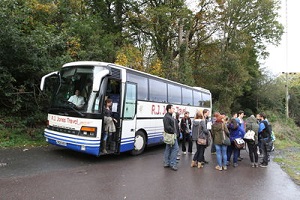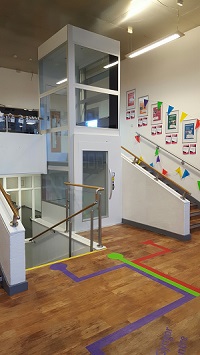Health, Safety and Environment Monthly Messages (2017)
To view previous Health, Safety and Environment Monthly Messages, please select from the tabs below:
December
 The Health, Safety and Environment Team would like to wish you all a Merry Christmas and a prosperous New Year. We look forward to continued collaboration will colleagues throughout 2018.
The Health, Safety and Environment Team would like to wish you all a Merry Christmas and a prosperous New Year. We look forward to continued collaboration will colleagues throughout 2018.
While Christmas lights transform homes and neighbourhoods over the holiday season, they can also introduce additional hazards to the home. The Royal Society for the Prevention of Accidents (ROSPA) provides the following in relation to Christmas lights safety.
Buying
- Look for safety marks e.g. BS Kitemark;
- Buy from a reputable store;
- Avoid buying second-hand unless you have them professionally checked first;
Checking
- NEVER insert or remove bulbs when switched on;
- Inspect cables and bulbs for damage;
- Do not use lights which are damaged, dispose of them safely.
Using
- Read and follow the manufacturer's instructions;
- Use an RCD (residual current device) for added protection against shock;
- Do not use the lights outdoors unless specifically made for such use;
- Don't run the cable under carpets or where it can be damaged;
- Keep lights clear of decorations and other flammable materials;
- Avoid cables becoming a tripping hazard;
- Use a stable support when hanging the lights;
- Don't leave the lights on when the room is empty. Remember to switch them off when you go to bed and when you go out of the house;
- Don't allow children to play with the lights.
Storing
- Take care when dismantling and packing the lights not to damage them;
- Keep them safely stored away out of reach of children;
- Avoid damp or excessively hot conditions.
Christmas can also represent a time for excesses. Any amount of alcohol can affect your ability to drive, and drink driving accounts for 14% of all road fatalities. It is not possible to say how much alcohol you can drink and stay below the limit — it depends on weight, age, sex, metabolism and of course, what you are drinking. You also don’t need to feel drunk necessarily to be a drink driver. If making the most of the festivities, please follow the THINK! Campaign’s advice:
- Beware the morning after - You could be over the legal limit many hours after your last drink
- There is no excuse for drink driving
- If you're planning to drink alcohol, plan how to get home without driving
- Don't offer an alcoholic drink to someone you know is planning to drive
- Don't accept a lift from a driver you know has drunk alcohol
November
As part of its recently launched ‘Go Home Healthy’ campaign, the Health and Safety Executive (HSE) have identified three main areas in terms of the protection of workers’ health. The three areas are:
- Work-Related Musculoskeletal Disorders;
- Work-Related Lung Disease;
- Work-Related Stress.
Musculoskeletal Disorders (MSDs) include injury and pain to backs, joints and limbs which can affect your quality of life. Both physical and psychosocial factors can contribute to work-related MSDs, and they can be aggravated by people’s activities outside work and their general health and fitness. According to latest estimates from the Labour Force Survey (2016), in Great Britain:
- The total number of MSDs cases in 2015/16 was 539,000 accounting for 41% of all work-related illnesses;
- An estimated 8.8 million working days were lost due to MSDs, an average of 16 days lost for each case. This accounts for 34% of all working days lost due to work related ill health.
- Agriculture, forestry and fishing, construction, transportation and storage and human health and social work activities are industries with significantly higher rates of WRMSDs when compared with the rates for all industries.
Important considerations for MSD’s include:
- You can do things to prevent or minimise MSDs;
- the prevention measures are generally cost effective;
- Early reporting of symptoms, proper treatment and suitable rehabilitation is essential.
There are a variety of precautionary measures an employer can take to reduce the risk of MSDs. The appropriate control measures can depend upon the sort of work undertaken by employees and what is 'reasonably practicable'. The first step is to assess all MSD risks that the tasks generate. Every effort should be made to eliminate as many risks as possible by redesigning the tasks, providing mechanical aids, introducing breaks or job rotation. When considering the risks, potential precautionary measures and solutions, ensure consultation with the workforce as they will often have first-hand knowledge of the risks associated with specific tasks. Once the precautionary measures have been introduced, monitor their effectiveness and ensure these measures have not introduced new risks. The HSE has produced a number of publications that provide potential solutions that may help with the choice of precautionary measure, some of which are industry-specific.
Further information relating to the HSE’s ‘Go Home Healthy’ Campaign is available at: http://www.hse.gov.uk/gohomehealthy/index.htm.
Further information relating to Musculoskeletal Disorders is available at: http://www.hse.gov.uk/msd/index.htm.
October
 It is illegal to use a handheld mobile when driving. This includes using your phone to follow a map, read a text or check social media, and also applies even if you’re stopped at traffic lights or queuing in traffic. When using mobile phones while driving, research has found that:
It is illegal to use a handheld mobile when driving. This includes using your phone to follow a map, read a text or check social media, and also applies even if you’re stopped at traffic lights or queuing in traffic. When using mobile phones while driving, research has found that:
- Drivers using a hands-free or handheld mobile phone are slower at recognising and reacting to hazards;
- You are four times more likely to be in a crash if you use your phone;
- Your reaction times are two times slower if you text and drive than if you drink drive, and this increases to three times if you use a handheld phone;
- Even careful drivers can be distracted by a call or text – and a split-second lapse in concentration could result in a crash.
This is because drivers who use both a hand-held or even hands-free mobile phone:
- are much less aware of what’s happening on the road around them;
- often take their eyes off the road altogether to look at the screen;
- fail to see road signs;
- fail to maintain proper lane position and steady speed;
- are more likely to ‘tailgate’ the vehicle in front;
- react more slowly and take longer to brake;
- are more likely to enter unsafe gaps in traffic;
- feel more stressed and frustrated.
You can only use a handheld phone if you are safely parked or need to call 999 or 112 in an emergency and it’s unsafe or impractical to stop. If you’re caught using a handheld phone while driving, you’ll get 6 penalty points on your licence and a fine of £200. Using hands free (e.g. for navigation) is not illegal, however, if this distracts you and affects your ability to drive safely, you can still be prosecuted by the police.
THINK!, the Department of Transport’s dedicated road safety website, have issued the following advice in respect of the use of mobile phones when driving:
- Put your phone away before driving so you won’t be tempted to use it. Make the glove compartment the phone compartment;
- Don't call other people when they're driving;
- Use hands free devices responsibly.
Further information is available via the Health and Safety Executive (HSE)’s ‘Driving at Work’ guidance, which is available at: http://www.hse.gov.uk/pubns/indg382.pdf
September
 When employing a young person under the age of 18, whether for work, work experience, or as an apprentice, employers have the same responsibilities for their health, safety and welfare as they would for any other employee.
When employing a young person under the age of 18, whether for work, work experience, or as an apprentice, employers have the same responsibilities for their health, safety and welfare as they would for any other employee.
The managing of significant risks in their workplaces is a legal requirement for all employees, and an additional assessment should be made to determine whether or not any additional controls are required for a young person. Prior to any employment or work experience, all associated risks must be appropriately managed.
If employing or facilitating work experience for a young person, an employer will need to review the relevant risk assessments for the activities to be undertaken by the young person, taking into account the specific factors for young people. This should be straightforward for low-risk activities, for example an office with everyday risks that will mostly be familiar to the young person. In such cases, existing arrangements should be sufficient, however the relevant risk assessments should still be reviewed before the activity(ies) can take place.
In less-familiar environments for young persons, arrangements should be specifically put in place to manage the associated risks. This should include a site induction, familiarisation, supervision and any personal protective equipment (PPE) as indicated in the risk assessment.
For work in higher-risk environments, the risks are likely to be greater and will need more careful attention to ensure they are properly controlled. If a workplace contains high risk hazards, employers should already have control measures in place.
Young persons should not, however, be expected or required to undertake any activities which expose them to hazards such as:
- Radiation
- Levels of noise breaching the lower exposure action value (xˉ 80 dB/day or week)
- Vibration
- Toxic Substances
- Extreme Temperatures
- Lasers
- Power Tools
- Alcohol
It should also be noted that there may also exist age limits on particular activities, for example, on some woodworking equipment. Anyone under the minimum age should not be allowed to use such equipment or undertake those activities.
The University’s Young Persons’ Policy is available at: https://www.aber.ac.uk/en/media/departmental/healthsafetyenvironment/Young-Persons-Policy-Final.pdf.
Further guidance is available from the Health and Safety Executive (HSE)’s Young People at Work pages, available at: http://www.hse.gov.uk/youngpeople/index.htm.
August
 Work at height means work in any place where, if precautions were not taken, a person could fall a distance liable to cause personal injury. This would include, but is not limited to:
Work at height means work in any place where, if precautions were not taken, a person could fall a distance liable to cause personal injury. This would include, but is not limited to:
- work above ground/floor level;
- fall from an edge, through an opening or fragile surface or;
- fall from ground level into an opening in a floor or a hole in the ground.
Work at height does not include a slip or a trip on the level, as a fall from height has to involve a fall from one level to a lower level, nor does it include walking up and down a permanent staircase in a building.
The Work at Height Regulations 2005 requires employers to ensure that:
- all work at height is properly planned and organised;
- those involved in work at height are competent;
- the risks from work at height are assessed, and appropriate work equipment is selected and used;
- the risks of working on or near fragile surfaces are properly managed;
- the equipment used for work at height is properly inspected and maintained.
When planning any work at height, colleagues must consider the following aspects:
- take account of weather conditions that could compromise worker safety;
- check that the place (eg a roof) where work at height is to be undertaken is safe. Each place where people will work at height needs to be checked every time, before use;
- stop materials or objects from falling or, if it is not reasonably practicable to prevent objects falling, take suitable and sufficient measures to make sure no one can be injured, eg use exclusion zones to keep people away or mesh on scaffold to stop materials such as bricks falling off;
- store materials and objects safely so they won’t cause injury if they are disturbed or collapse;
- plan for emergencies and rescue, eg agree a set procedure for evacuation. Think about foreseeable situations and make sure employees know the emergency procedures. Don’t just rely entirely on the emergency services for rescue in your plan.
Before undertaking any work from height, colleagues should satisfy the following steps:
- avoid work at height where it is reasonably practicable to do so;
- where work at height cannot be avoided, prevent falls using either an existing place of work that is already safe or the right type of equipment;
- minimise the distance and consequences of a fall, by using the right type of equipment where the risk cannot be eliminated.
Examples of the types of control measures to be implemented would include:
- do as much work as possible from the ground;
- ensure workers can get safely to and from where they work at height;
- ensure equipment is suitable, stable and strong enough for the job, maintained and checked regularly;
- make sure you don’t overload or overreach when working at height;
- take precautions when working on or near fragile surfaces;
- provide protection from falling objects;
- consider your emergency evacuation and rescue procedures.
Information relation to working at height is available at: https://www.aber.ac.uk/en/hse/proc-prac/working-at-height/.
Further information is available on the Health and Safety Executive (HSE) website: http://www.hse.gov.uk/work-at-height/index.htm
July
 The Control of Vibration at Work Regulations 2005 focus on the elimination or control of vibration exposure, and introduce action and limit values for hand-arm and whole-body vibration. The regulations require that employers:
The Control of Vibration at Work Regulations 2005 focus on the elimination or control of vibration exposure, and introduce action and limit values for hand-arm and whole-body vibration. The regulations require that employers:
- make sure that risks from vibration are controlled;
- provide information, instruction and training to employees on the risk and the actions being taken to control risk; and
- provide suitable health surveillance.
Hand-arm vibration is vibration transmitted into workers’ hands and arms. This can come from use of hand-held power tools (such as grinders or road breakers), hand-guided equipment (such as powered lawnmowers or pedestrian controlled floor saws) or by holding materials being worked by hand-fed machines (such as pedestal grinders or forge hammers).
Regular and frequent exposure to hand-arm vibration can lead to two forms of permanent ill health known as:
- hand-arm vibration syndrome (HAVS); and
- carpal tunnel syndrome (CTS).
Symptoms and effects of HAVS include:
- tingling and numbness in the fingers which can result in an inability to do fine work (for example, assembling small components) or everyday tasks (for example, fastening buttons);
- loss of strength in the hands which might affect the ability to do work safely;
- the fingers going white (blanching) and becoming red and painful on recovery, reducing ability to work in cold or damp conditions, e.g. outdoors.
HAVS is preventable, but once the damage is done it is permanent. Colleagues with any concerns relating to their use of vibrating equipment should contact their line manager immediately. The most efficient and effective way of controlling exposure to hand-arm vibration is to look for new or alternative work methods which eliminate or reduce exposure to vibration. Once the likelihood of risk has been established you should look more closely at which workers, or groups of workers, are likely to be at risk and what can be done to reduce those risks, through completion of risk assessment.
Further information relating to hand-arm vibration at work is available via the Health and Safety Executive website at: http://www.hse.gov.uk/vibration/hav/.
For any further information, please contact the Health, Safety and Environment Team at hasstaff@aber.ac.uk or on extension 2073.
June
 As the summer months approach, colleagues are reminded to take care when in the sun and consider the effect on their skin. Research has found that getting painful sunburn just once every two years can triple the risk of the most deadly form of skin cancer, malignant melanoma.
As the summer months approach, colleagues are reminded to take care when in the sun and consider the effect on their skin. Research has found that getting painful sunburn just once every two years can triple the risk of the most deadly form of skin cancer, malignant melanoma.
Sun exposure is the main cause of skin cancer, and is linked to 65% of malignant melanoma and 99% of non-melanoma skin cancer. In 2015, the Institution of Occupational Safety and Health (IOSH) published research into solar radiation exposure at work in Britain, which revealed that malignant melanoma kills on average around 60 people each year. There are at least 1,500 new cases of non-melanoma skin cancer recorded each year and 240 new cases of malignant melanoma linked to solar radiation exposure through work.
The risks from ultraviolet radiation are especially relevant to colleagues who work outside as part of their regular working activities. Outdoor workers will typically receive 5-10 times the yearly sun exposure of indoor workers. The dangers will also exist during cloudy days as up to 80% of dangerous UV rays can pass through clouds.
IOSH propose the following five steps to protect your skin from harmful ultraviolet radiation from the sun while working:
- Cover Up – Wear long, loose clothing to keep the sun off your skin.
- Protect Your Head – Don’t forget your head, face, ears and neck – wear a hat, preferably with a wide brim, and sunglasses with UV protection.
- Seek Shade – Come out of the sun whenever possible during the most powerful ultraviolet periods (10am-3pm), and remember to stay in the shade during breaks.
- Use Sunscreen – Use SPF 30 or higher on any exposed skin – apply it half an hour before going outside, put plenty on and reapply it frequently.
- Be Skin Safe – Report mole changes (size, shape, colour, itching or bleeding) or any other concerns about your skin to your doctor as soon as possible – don’t put it off as early treatment is important.
Further information relating to staying safe in the sun is available on the NHS website at: http://www.nhs.uk/Livewell/skin/Pages/Sunsafe.aspx.
May
 Colleagues will already be aware of the recently introduced Travel Policy, which notes the requirements for facilitating travel for the purposes of University-related business.
Colleagues will already be aware of the recently introduced Travel Policy, which notes the requirements for facilitating travel for the purposes of University-related business.
Travel is often an essential and unavoidable part of the working day for many due to the nature of the University’s teaching, research and commercial activities. It's therefore critical that all members of staff familiarise themselves with the University's Travel Policy and accompanying guidance notes, particularly if regularly engaging in travel for any type of University-related business.
In particular, colleagues should consider and address the following issues before any type of University-related travel is undertaken:
- Authorisation - Appropriate authorisation must be sought before any travel is undertaken. The requirements for authorisation will consider the Foreign and Commonwealth Office (FCO) advice, and will generally involve one of the following permutations;
- Where domestic travel (i.e. within the United Kingdom) is to be undertaken;
- Where there are no travel restrictions imposed by the Foreign and Commonwealth Office (FCO);
- Where the FCO advises against all travel to countries or regions unless on essential business;
- Where the FCO advises against all travel to countries or regions;
- Travel to Home Country or Region;
- Risk Assessment – Travel should be considered as part of the risk assessment process. The risk assessment should be produced prior to authorisation, and must be included for consideration by the authorising member of staff.
- Foreign and Commonwealth Office (FCO) Travel Advice – Travel Risk Assessments should consider and make reference to the latest Foreign and Commonwealth Office (FCO) travel advice for the country or region to be visited. The latest FCO Travel Advice is available at: https://www.gov.uk/foreign-travel-advice.
- Travel Cover - Travel Cover must be arranged before any overseas travel can take place. This can be arranged by contacting the Finance Department at travel@aber.ac.uk.
- Travel Itinerary and Details – Colleagues within the Institute or Department should have access to a full travel itinerary and emergency contact details.
All colleagues should have an awareness and understanding of the requirements of the Travel Policy, which is available at: https://www.aber.ac.uk/en/media/departmental/healthsafetyenvironment/Aberystwyth-University-Travel-Policy.pdf.
Further information relating to travel is available at: https://www.aber.ac.uk/en/hse/proc-prac/travel/.
April
 The Lifting Operations and Lifting Equipment Regulations 1998 (LOLER) place duties on organisations who own, operate or have control over lifting equipment. In most cases, lifting equipment is also work equipment so the Provision and Use of Work Equipment Regulations (PUWER) will also apply (including inspection and maintenance).
The Lifting Operations and Lifting Equipment Regulations 1998 (LOLER) place duties on organisations who own, operate or have control over lifting equipment. In most cases, lifting equipment is also work equipment so the Provision and Use of Work Equipment Regulations (PUWER) will also apply (including inspection and maintenance).
'Lifting equipment' means work equipment for lifting and lowering loads and includes lifting accessories and attachments used for anchoring, fixing or supporting the equipment. Examples of lifting equipment include:
- overhead cranes and their supporting runways;
- patient hoists;
- motor vehicle lifts;
- vehicle tail lifts and cranes fitted to vehicles;
- a building cleaning cradle and its suspension equipment;
- goods and passenger lifts;
- telehandlers and fork lifts;
- lifting accessories.
Where you undertake lifting operations involving lifting equipment you must:
- plan them properly;
- using people who are sufficiently competent;
- supervise them appropriately;
- to ensure that they are carried out in a safe manner.
LOLER also requires that all equipment used for lifting is fit for purpose, appropriate for the task, suitably marked and, in many cases, subject to statutory periodic 'thorough examination'. Records must be kept of all thorough examinations and any defects found must be reported to both the person responsible for the equipment and the relevant enforcing authority.
Testing of LOLER equipment is co-ordinated by the Estates Department, who maintain a central register of all LOLER equipment, however they must be notified of all new or existing lifting equipment used in Institutes and Professional Service Departments. If you’re aware of any lifting equipment in your department, but are not sure whether it has included on the central register, please contact the Estates Department immediately to confirm.
Further information relating to LOLER is available at: http://www.hse.gov.uk/work-equipment-machinery/loler.htm.
For any guidance or advice, please contact the Health, Safety and Environment Team at hasstaff@aber.ac.uk or on extension 2073.
March
 All new members of staff, including those moving to new roles within the University, are required to undertake and complete a local Health, Safety and Environment Induction. The Induction Report Form should be completed within two weeks of commencing in the post, and is available at: https://www.aber.ac.uk/en/hse/training/hseinduction/.
All new members of staff, including those moving to new roles within the University, are required to undertake and complete a local Health, Safety and Environment Induction. The Induction Report Form should be completed within two weeks of commencing in the post, and is available at: https://www.aber.ac.uk/en/hse/training/hseinduction/.
The induction should include an introduction to local arrangements and matters relating to health, safety and environment, and involve the completion of the following sections of the Health, Safety and Environment Induction Report Form:
- Fire Safety Arrangements
- First Aid Arrangements
- Incident Reporting Procedure
- Reporting Issues or Faults
- Health, Safety and Environment Policies and Procedures
- Prevent Duty Awareness
- Institute / Professional Service Department Safety Rules and Procedures
- Health and Safety Essentials E-Learning
- Other (as applicable)
The Institute or Professional Service Department Health and Safety Handbook is a means by which Institutes and Professional Service Departments can convey local health, safety and environment arrangements to both new and existing members of staff. Any new colleagues should be provided with or made aware of the location of their local Institute / Professional Service Department Health and Safety Handbook.
During the local health, safety and environment induction, training requirements for all new members of staff must be considered. Two-way consultation must take place between employee and manager or supervisor to identify essential training to enable staff to undertake their work safely. This can include, but is not restricted to, on-the-job sessions, internal classes and/or external courses. Appropriate courses should be decided following consideration for the control measures identified in the risk assessments for the activities undertaken by the individual, and/or the training courses noted in the Institute or Professional Service Department’s training matrix.
For further information relating to the training courses offered by the Health, Safety and Environment Team, please go to: https://www.aber.ac.uk/en/hse/training/.
A key requirement of this process is the completion of the relevant modules of the Health and Safety Essentials E-Learning training course. The modules available provide a broad introduction to the primary principles and considerations associated with the most common health, safety and environment topics. Each module should take around 10-15 minutes to complete, and are available for each ofthe following topics:
- Environmental Awareness
- Asbestos Awareness
- Avoiding Violence
- Dealing with Hazardous Substances
- Getting to Grips with Health and Safety
- Lifting and Carrying Safely
- Managing Occupational Road Risk
- Meeting the Threat from Fire
- Reporting Health and Safety Incidents
- Stress Busting
- Working at Height
- Working Safely with Computers
For further information on the Health and Safety Essentials E-Learning training modules, please go to: https://www.aber.ac.uk/en/hse/training/hseessentials/.
For any further information relating to local health, safety and environment inductions, please contact the Health, Safety and Environment Team at hasstaff@aber.ac.uk or on extension 2073.
February
 The Control of Substances Hazardous to Health (COSHH) Regulations 2002 require employers to control substances that are hazardous to health, and prevent or reduce employee exposure to such substances. COSHH substances can take many forms and include chemicals, fumes, dusts, vapours, nanotechnology, gases and asphyxiating gases, and biological agents.
The Control of Substances Hazardous to Health (COSHH) Regulations 2002 require employers to control substances that are hazardous to health, and prevent or reduce employee exposure to such substances. COSHH substances can take many forms and include chemicals, fumes, dusts, vapours, nanotechnology, gases and asphyxiating gases, and biological agents.
Methods of managing the risks associated with substances hazardous to health include:
- finding out what the health hazards are;
- deciding how to prevent harm to health;
- providing control measures to reduce harm to health;
- making sure that the control measures are observed;
- keeping all control measures in good working order;
- providing information, instruction and training for employees and others;
- providing monitoring and health surveillance in appropriate cases;
- planning for emergencies (e.g. availability of suitable spill kits).
Suitable control measures will be identified and included in the COSHH Risk Assessment.
By law, all suppliers of chemicals must provide an up to date safety data sheet if a substance is dangerous or potentially hazardous to health. The safety data sheets describe the hazards the chemical presents, and gives information on handling, storage and emergency measures in case of an incident. You should, however, note that a safety data sheet is not a risk assessment. Rather, the information included in the COSHH Safety Data Sheet will assist in the production of the COSHH Risk Assessment.
The fundamentals of COSHH Risk Assessments involve five key stages:
- Gather information about the substances, the work and working practices;
- Evaluate the risks to health;
- Decide what needs to be done;
- Record the assessment;
- Review the assessment.
All COSHH Risk Assessments should be signed and dated by a competent person and be readily accessible alongside the COSHH Data Sheets to all members of staff who have access to, or are working with, hazardous substances. Examples of effective storage arrangements are at the point of use (such as in a folder kept exclusively in a laboratory), or on a readily accessible file store (such as SharePoint site).
Further information relating to the Control of Substances Hazardous to Health are available at: https://www.aber.ac.uk/en/hse/proc-prac/coshh/.
Details of the Introduction to CoSHH Training Course, offered by the Health, Safety and Environment Department, are available at: https://www.aber.ac.uk/en/hse/training/coshh-training/.
January
 During the winter months, the weather can be unpredictable and change quickly, which in turn can make roads dangerous or treacherous. Factors such as visibility and stopping distances can be significantly affected by road conditions. Brake, a road safety charity, provides the following advice for winter and bad weather driving:
During the winter months, the weather can be unpredictable and change quickly, which in turn can make roads dangerous or treacherous. Factors such as visibility and stopping distances can be significantly affected by road conditions. Brake, a road safety charity, provides the following advice for winter and bad weather driving:
Avoid Driving
If at all possible, avoid driving in snow and other treacherous conditions. Never set off when it's snowing heavily or if it’s forecast to snow, and avoid driving if you possibly can in other bad conditions like fog, heavy rain and ice. In such instances, consider alternatives like public transport.
Be Prepared
Even if you avoid setting off in adverse weather conditions, you could be caught out. Ways in which you can be prepared include:
- Ensuring your vehicle is well-maintained through an up-to-date MOT, regular service, and regular walk-round checks by you;
- Regularly checking tyres to ensure they’re in good condition and have a tread depth of at least 3mm to be safe in the wet;
- Making sure there is anti-freeze in your radiator and windscreen washer bottle;
- Keeping an ice-scraper and de-icer in your vehicle at all times in winter;
- Packing a winter driving kit in case of emergency - this might include: a torch; cloths; a blanket and warm clothes; food and drink; first-aid kit; spade; warning triangle; and high-visibility vest;
- Always take a well-charged phone in case of emergencies, but don't be tempted to use it when driving.
Other ways of reducing the risks from journeys include:
- Checking car batteries to ensure that they are not in need of being replaced;
- Clearing ice, snow and condensation completely from the windscreen and all windows before setting off. Clear snow off the roof of your vehicle too, as it might fall and obscure your vision during your journey;
- Check forecasts and plan your route carefully. In bad weather, major roads are more likely to be cleared and gritted;
- Allow plenty of time for potential hold-ups.
Careful, Cautious Driving
If you do get caught in bad weather, measures to minimise the risks and dangers include:
- Slowing down - if visibility is poor or the road is wet or icy, it will take you longer to react to hazards and you should reduce your speed accordingly;
- Maintain a safe gap behind the vehicle in front - the gap between you and the vehicle in front is your braking space in a crisis. Stopping distances are double in the wet, and can be 10 times greater in icy weather;
- Be extra vigilant for people and hazards - people on foot, bicycles, motorbikes and horses are harder to spot in adverse weather;
- Stay in control - avoid harsh braking and acceleration, and carry out manoeuvres very slowly and with extra care;
- Use lights - put lights on in gloomy weather and when visibility is reduced.
For further information relating to road safety, please see the Brake road safety charity website at: http://www.brake.org.uk/.
